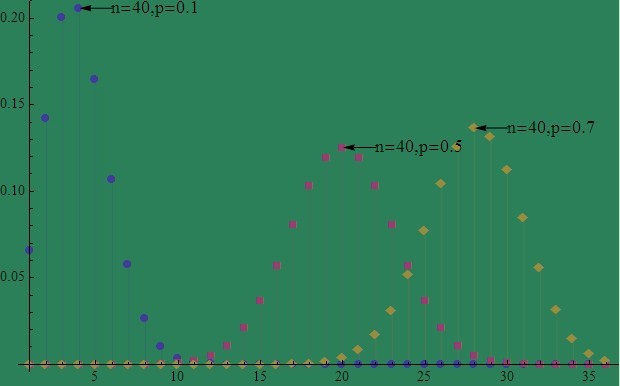博文
The Binomial Probability Distribution(二项分布)
|||
A binomial experiment possesses the following properties:
1. The experiment consists of a fixed number, n, of identical trials.
2. Each trial results in one of two outcomes: success, S, or failure, F.
3. The probability of success on a single trial is equal to some value p and remains the same from trial
1. The experiment consists of a fixed number, n, of identical trials.
2. Each trial results in one of two outcomes: success, S, or failure, F.
3. The probability of success on a single trial is equal to some value p and remains the same from trial
to trial. The probability of a failure is equal to q = (1 − p).
4. The trials are independent.
5. The random variable of interest is Y , the number of successes observed during the n trials.
4. The trials are independent.
5. The random variable of interest is Y , the number of successes observed during the n trials.
Definition:
A random variable Y is said to have a binomial distribution based on n trials with success probability p if
and only if
$$p(y) = left( {begin{array}{*{20}{c}} n\ y end{array}} right){p^y}{q^{n - y}},;;y = 0,;1,;2,;...,;n;{rm{and}};0 le p le 1.$$
You can use the following Mathematica command to obtain the probability
PDF[BinomialDistribution[n, p], y]// TraditionalForm
Relative Mathematica Functions
Relative Mathematica Functions
Binomial[n,m] gives the binomial coefficient $left( {begin{array}{*{20}{c}} n\ m end{array}} right)$
BinomialDistribution[n,p] represents a binomial distribution with n trials and success probability p.
Examples:
A = BinomialDistribution[40, p];
M = Median[A];
a := {Arrowheads[0.02], Arrow[{{M + 2, PDF[A, M]}, {M, PDF[A, M]}}]};
t := Text[Style["n=40,p=" <> ToString[p], Medium], {M + 2, PDF[A, M]}, {-1, 0}];
epilog = Table[{a, t}, {p, {0.1, 0.5, 0.7}}];
DiscretePlot[Evaluate@Table[PDF[A, k], {p, {0.1, 0.5, 0.7}}], {k, 36},PlotRange -> All, PlotMarkers ->
M = Median[A];
a := {Arrowheads[0.02], Arrow[{{M + 2, PDF[A, M]}, {M, PDF[A, M]}}]};
t := Text[Style["n=40,p=" <> ToString[p], Medium], {M + 2, PDF[A, M]}, {-1, 0}];
epilog = Table[{a, t}, {p, {0.1, 0.5, 0.7}}];
DiscretePlot[Evaluate@Table[PDF[A, k], {p, {0.1, 0.5, 0.7}}], {k, 36},PlotRange -> All, PlotMarkers ->
Automatic, Epilog -> epilog,Background -> RGBColor[0.1, 0.45, 0.3, 0.9]]
https://blog.sciencenet.cn/blog-531885-597364.html
上一篇:Matlab中 pdist 函数详解(各种距离的生成)
下一篇:The Geometric Probability Distribution(几何分布)
